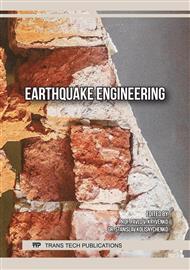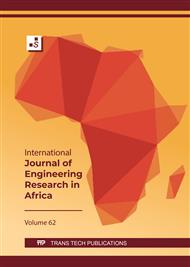[1]
S. Shahzad, A. Toumi, J.-P. Balayssac, A. Turatsinze, and V. Mazars, Cementitious composites incorporating Multi-Walled Carbon Nanotubes (MWCNTs): effects of annealing and other dispersion methods on the electrical and mechanical properties, Matériaux & Techniques. 110 (2022) 1-14. https://doi.org/10.1051/mattech/2022020.
DOI: 10.1051/mattech/2022020
Google Scholar
[2]
M. Stefanoni, U. Angst, and B. Elsener, Corrosion challenges and opportunities in digital fabrication of reinforced concrete, RILEM International Conference on Concrete and Digital Fabrication. (2018) 225–233. https://doi.org/10.1007/978-3-319-99519-9_21.
DOI: 10.1007/978-3-319-99519-9_21
Google Scholar
[3]
S. Wilkie and T. Dyer, Design and durability of early 20th century concrete bridges in Scotland: A review of historic test data, International Journal of Architectural Heritage. 16 (2022) 1131-1151. https://doi.org/10.1080/15583058.2020.1870776.
DOI: 10.1080/15583058.2020.1870776
Google Scholar
[4]
F. Qu, W. Li, W. Dong, V. W. Tam, and T. Yu, Durability deterioration of concrete under marine environment from material to structure: A critical review, Journal of Building Engineering. 35 (2021) 102074. https://doi.org/10.1016/j.jobe.2020.102074.
DOI: 10.1016/j.jobe.2020.102074
Google Scholar
[5]
C. Maraveas, Durability issues and corrosion of structural materials and systems in farm environment, Applied Sciences. 10 (2020) 990. https://doi.org/10.3390/app10030990.
DOI: 10.3390/app10030990
Google Scholar
[6]
M. Alexander and H. Beushausen, Durability, service life prediction, and modelling for reinforced concrete structures–review and critique, Cement and Concrete Research. 122 (2019) 17–29. https://doi.org/10.1016/j.cemconres.2019.04.018.
DOI: 10.1016/j.cemconres.2019.04.018
Google Scholar
[7]
L. Zhou, S. Guo, Z. Zhang, C. Shi, Z. Jin, and D. Zhu, Mechanical behavior and durability of coral aggregate concrete and bonding performance with fiber-reinforced polymer (FRP) bars: A critical review, Journal of Cleaner Production. 289 (2021) 125652. https://doi.org/10.1016/j.jclepro.2020.125652.
DOI: 10.1016/j.jclepro.2020.125652
Google Scholar
[8]
G. A. Anwar, Y. Dong, and C. Zhai, Performance-based probabilistic framework for seismic risk, resilience, and sustainability assessment of reinforced concrete structures, Advances in Structural Engineering. 23 (2020) 1454–1472. https://doi.org/10.1177/1369433219895363.
DOI: 10.1177/1369433219895363
Google Scholar
[9]
G. L. Golewski, On the special construction and materials conditions reducing the negative impact of vibrations on concrete structures, Materials Today: Proceedings. 45 (2021) 4344–4348. https://doi.org/10.1016/j.matpr.2021.01.031.
DOI: 10.1016/j.matpr.2021.01.031
Google Scholar
[10]
C. Petrone, T. Rossetto, M. Baiguera, C. De la Barra Bustamante, and I. Ioannou, Fragility functions for a reinforced concrete structure subjected to earthquake and tsunami in sequence, Engineering Structures. 205 (2020) 110120. https://doi.org/10.1016/j.engstruct.2019.110120.
DOI: 10.1016/j.engstruct.2019.110120
Google Scholar
[11]
Preliminary Damage and Needs Assessment. Accessed: Jul. 10, 2022. [Online]. Available: https://documents1.worldbank.org/curated/en/710481468284380489/pdf/34407.pdf.
Google Scholar
[12]
R. Spence, E. So, S. Jenkins, A. Coburn, and S. Ruffle, A global earthquake building damage and casualty database, in Human Casualties in Earthquakes, Springer. 29 (2011). https://doi.org/10.1007/978-90-481-9455-1_5.
DOI: 10.1007/978-90-481-9455-1_5
Google Scholar
[13]
S. Doocy, A. Daniels, C. Packer, A. Dick, and T. D. Kirsch, The human impact of earthquakes: a historical review of events 1980-2009 and systematic literature review, PLoS currents. 5 (2013). https://doi.org/10.1371/currents.dis.67bd14fe457f1db0b5433a8ee20fb833.
DOI: 10.1371/currents.dis.67bd14fe457f1db0b5433a8ee20fb833
Google Scholar
[14]
S. Saba, F. Ahsan, and S. Mohsin, BAT-ANN based earthquake prediction for Pakistan region, Soft Computing. 21 (2017) 5805-5813. https://doi.org/10.1007/s00500-016-2158-2.
DOI: 10.1007/s00500-016-2158-2
Google Scholar
[15]
K. M. Sreejith, M. C. M. Jasir, R. Agrawal, and A. S. Rajawat, The 2019 September 24, Mw= 6, Mirpur earthquake, NW Himalaya: Geodetic evidence for shallow, near-horizontal décollement rupture of the Main Himalayan Thrust, Tectonophysics. 816 (2021) 229013. https://doi.org/10.1016/j.tecto.2021.229013.
DOI: 10.1016/j.tecto.2021.229013
Google Scholar
[16]
M. Shafique and M. Y. Khan, Earthquake hazards and risk mitigation in Pakistan, in Disaster risk reduction approaches in Pakistan, Springer. (2015) 101–117. https://doi.org/10.1007/978-4-431-55369-4_5.
DOI: 10.1007/978-4-431-55369-4_5
Google Scholar
[17]
H. V. GangaRao, N. Taly, and P. V. Vijay, Reinforced concrete design with FRP composites, CRC press. (2006). https://doi.org/10.1201/9781420020199.
DOI: 10.1201/9781420020199
Google Scholar
[18]
A. Hosseini, A. R. Khaloo, and S. Fadaee, Seismic performance of high-strength concrete square columns confined with carbon fiber reinforced polymers (CFRPs), Canadian Journal of Civil Engineering. 32 (2005) 569–578. https://doi.org/10.1139/l05-006.
DOI: 10.1139/l05-006
Google Scholar
[19]
A. P. Sakthieswaran, Jute Fibre Wrapped RC Short Column, International Journal for Innovative Research in Science & Technology. 2 (2015) 54-60. http://www.ijirst.org/articles/IJIRSTV2I1016.pdf.
Google Scholar
[20]
S. Kaza, L. Yao, P. Bhada-Tata, and F. Van Woerden, What a waste 2.0: a global snapshot of solid waste management to 2050, World Bank Publication (2018). [Online]. Available: https://openknowledge.worldbank.org/handle/10986/30317.
DOI: 10.1596/978-1-4648-1329-0
Google Scholar
[21]
K. Nadeem, S. Shahzad, A. Hassan, M. Usman Younus, S. Asad Ali Gillani, and K. Farhan, Municipal solid waste generation and its compositional assessment for efficient and sustainable infrastructure planning in an intermediate city of Pakistan, Environmental Technology, (2022) 1-19. https://doi.org/10.1080/09593330.2022.2054370.
DOI: 10.1080/09593330.2022.2054370
Google Scholar
[22]
A. Bamba et al., Challenges and emerging solutions to the land-based plastic waste issue in Africa, (2018) https://doi.org/10.1016/j.marpol.2017.10.041.
Google Scholar
[23]
K. Okazaki, K. S. Pribadi, D. Kusumastuti, and T. Saito, Comparison of current construction practices of non-engineered buildings in developing countries, (2012). [Online]. Available: https://www.iitk.ac.in/nicee/wcee/article/WCEE2012_1696.pdf.
Google Scholar
[24]
World Bank Country and Lending Groups – World Bank Data Help Desk. https://datahelpdesk.worldbank.org/knowledgebase/articles/906519 (accessed Jul. 10, 2022).
Google Scholar
[25]
Standard Specification for Portland Cement, ASTM C150.
Google Scholar
[26]
A. C. I. Committee, Building code requirements for structural concrete (ACI 318-11) and commentary, American Concrete Institute. (2011). [Online]. Available: https://www.concrete.org/store/productdetail.aspx?ItemID=318U11&Language=English&Units=US_Units.
Google Scholar
[27]
DIN 53452: Testing of Plastics; Flexural Test. Deutsches Institut fur Normung E.V. (DIN), (1977). Accessed: Jul. 18, 2022. [Online]. Available: https://www.beuth.de/en/standard/din-53452/1646226.
DOI: 10.1163/9789004337862__com_040490
Google Scholar
[28]
BIS, IS456. 456 (2000) Plain and reinforced concrete-Code of Practice., Bureau of Indian Standards, New Delhi, India (2000). https://www.iitk.ac.in/ce/test/IS-codes/is.456.2000.pdf.
Google Scholar
[29]
L. Daniel and A. Loukili, Behavior of high strength fiber-reinforced concrete beams under cyclic loading, Structural Journal. 99 (2002) 248-256. https://doi.org/10.14359/11908.
DOI: 10.14359/11908
Google Scholar
[30]
B. D. Stemper, D. Board, N. Yoganandan, and C. E. Wolfla, Biomechanical properties of human thoracic spine disc segments, Journal of Craniovertebral Junction and Spine. 1 (2010) 18. https://doi.org/10.4103/0974-8237.65477.
DOI: 10.4103/0974-8237.65477
Google Scholar
[31]
H. Nakamura, T. Nanri, T. Miura, and S. Roy, Experimental investigation of compressive strength and compressive fracture energy of longitudinally cracked concrete, Cement and Concrete Composites. 93 (2018) 1-18. https://doi.org/10.1016/j.cemconcomp.2018.06.015.
DOI: 10.1016/j.cemconcomp.2018.06.015
Google Scholar



